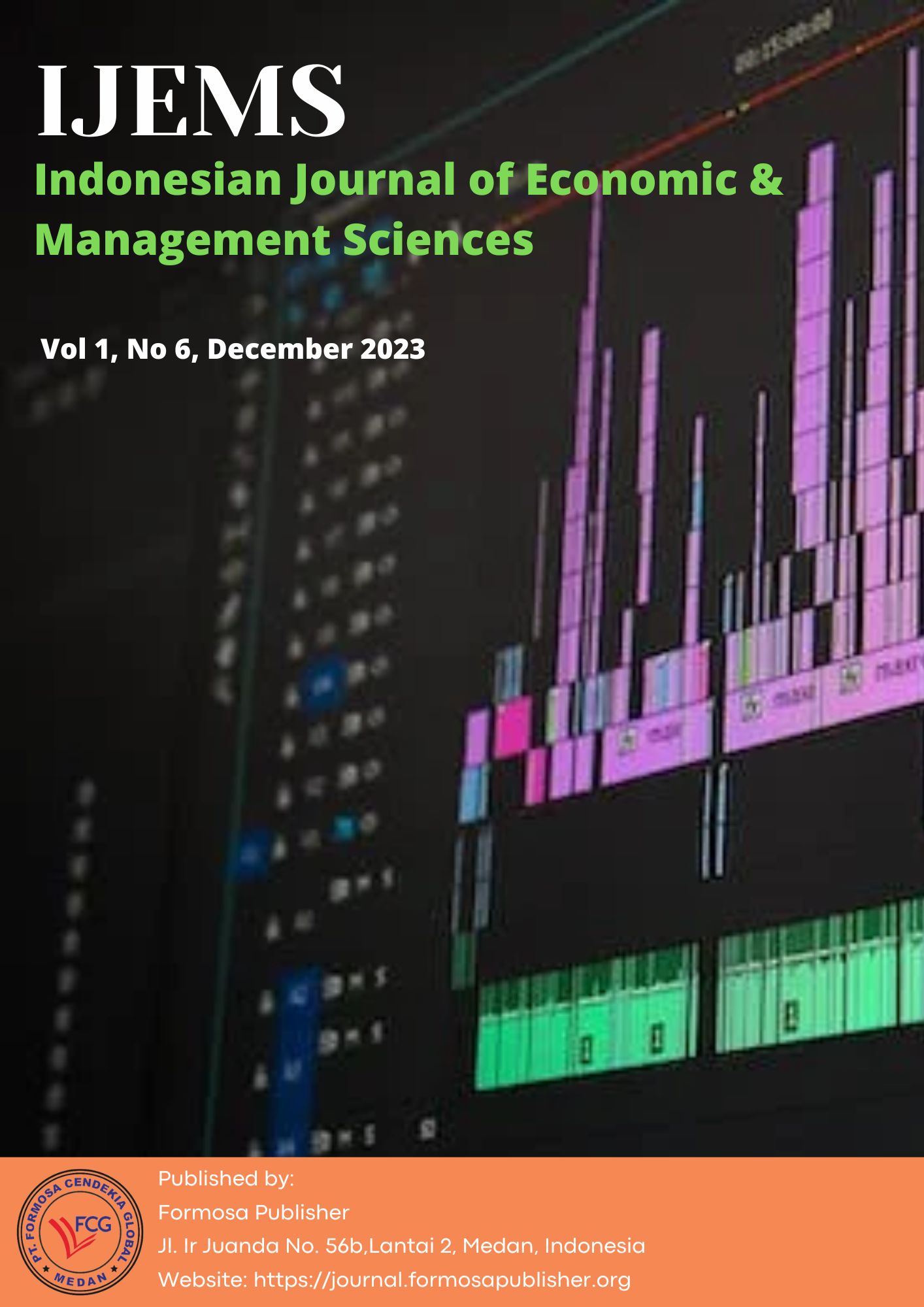Green Innovation for Small-to Medium-Sized Enterprises (SMEs): Systematic Literature Review
DOI:
https://doi.org/10.55927/ijems.v1i6.7274Keywords:
Green Innovation, SMEs, Systematic Literatur ReviewAbstract
The green innovation literature of the past few decades is not only interesting for research due to its high level of environmental awareness and the provision of green products and services, but also because of its widespread and important applications. This study aims to determine research trends related to the adoption of green innovation, especially in SMEs during 2013-2023 by using Systematic Literature Review techniques. The result of this research identifies the key elements factors of GI for managers and ultimately serve as an important reference to help formulate GI activity strategies. This research can serve as a foundation for scientific development so that the number of studies related to new topics related to green innovation also continues to increase
Downloads
References
Abadzhiev, A., Sukhov, A., Sihvonen, A. and Johnson, M. (2022). Managing the complexity of green innovation. European Journal of Innovation Management, Vol. 25 No. 6, pp. 850-866.
Aeknarajindawat, N. & Jermsittiparsert, K. (2019). The Mediating Role of Green Creativity in the Relationship between Proactive Green Innovation, Reactive Green Innovation and the Performance of Green Product Development: A Case of Thai Sports Manufacturing Firms. Journal of Human Sport and Exercise.
Albort-Morant, G., Leal-Millan, A. and Cepeda-Carrion, G. (2016). The antecedents of green innovation performance: a model of learning and capabilities. Journal of Business Research, Vol. 69 No. 11, pp. 4912-4917.
Amores-Salvadó, J., Martín-de Castro, G., & Navas-López, J. E. (2014). Green corporate image: Moderating the connection between environmental product innovation and firm performance. Journal of Cleaner Production, 83: 356–365.
Antonioli, D., Mancinelli, S. & Mazzanti, M. (2013). Is environmental innovation embedded within high-performance organisational changes? The role of human resource management and complementarity in green business strategies. Research Policy, Vol. 42 No. 4, pp. 975-988.
Ardito, L., A. M. Petruzzelli, F. Pascucci & E. Peruffo. (2018). Inter-firm R&D collaborations and green innovation value: The role of family firms' involvement and the moderating effects of proximity dimensions. Business Strategy and the Environment 28 (1).
Arfi, WB., L. Hikkerova, JM Sahut. (2018). External knowledge sources, green innovation and performance. Technological Forecasting and Social Change 129, 210-220.
Benkraiem, R., E. Dubocage, Y. Lelong & F. Shuwaikh. (2023). The effects of environmental performance and green innovation on corporate venture capital. Ecological Economics 210.
Berrone, P., Fosfuri, A., Gelabert, L. and Gomez-Mejia, L.R. (2013). Necessity as the mother of ‘green’ inventions: institutional pressures and environmental innovations. Strategic Management Journal, Vol. 34 No. 8, pp. 891-909.
Cao, B. & Wang, S. (2017). Opening up, international trade, and green technology progress. Journal of Cleaner Production, Vol. 142, pp. 1002-1012.
Cui, R., Wang, J., Xue, Y., & Liang, H. (2020). Interorganizational learning, green knowledge integration capability and green innovation. European Journal of Innovation Management.
Dhull, S. and Narwal, M. (2016). Drivers and barriers in green supply chain management adaptation: a state-of-art review. Uncertain Supply Chain Management, Vol. 4 No. 1, pp. 61-76.
Dougherty, D. (2017). Taking advantage of emergence for complex innovation eco-systems. Journal of Open Innovation: Technology, Market, and Complexity, Vol. 3 No. 3, p. 14.
Fankhauser, S. et al. (2013). Who will win the green race? In search of environmental competitiveness and innovation. Global Environmental Change 23 (5), 902-913.
Granero, E. M. G., Muñoz, L. P. & Gómez, E. G., (2018). Eco-innovation measurement: A review of firm performance indicators. Journal of Cleaner Production 191, 304-317.
Hojnik, J. and Ruzzier, M. (2016). The driving forces of process eco-innovation and its impact on performance: insights from Slovenia. Journal of Cleaner Production, Vol. 133, pp. 812-825.
Huang, Y. C., & Yang, M. L. (2014). Reverse logistics innovation, institutional pressures and performance. Management Research Review 37 (7), 615–641.
Imran, H., A.H. Habbe & M.I. Ferdiansah. (2015). The Role of Information Technology as Moderating Variable and Internal Control Effectiveness as Intervening Variable in The Relationship Between Human Resource Competency and Internal Auditor Service Quality on Quality of Report. Asia-Pacific Management Accounting Association (APMAA), 1-50.
Jun, W., Ali, W., Bhutto, M. Y., Hussain, H., & Khan, N. A. (2019). Examining the determinants of green innovation adoption in SMEs: a PLS-SEM approach. European Journal of Innovation Management, 24(1), 67–87.
Kousar, S., Sabri, P.S., Zafar, M. and Akhtar, A. (2017). Technological factors and adoption of green innovation – moderating role of government intervention: a case of SMEs in Pakistan. Journal of Commerce and Social Sciences, Vol. 11 No. 3, pp. 833-861.
Lai, X., S Yue, H Chen. (2022). Can green credit increase firm value? Evidence from Chinese listed new energy companies. Environmental Science and Pollution Research 29, 18702–18720.
Li, X., J. Yang, H. Liu, X. Zhuang. (2021). Entrepreneurial orientation and green management in an emerging economy: The moderating effects of social legitimacy and ownership type. Journal of Cleaner Production 316.
Lin, H., Zeng, S. X., Ma, H. Y., Qi, G. Y., & Tam, V. W. (2014). Can political capital drive corporate green innovation? Lessons from China. Journal of Cleaner Production 64 (1), 63–72.
Lv, C., Shao, C., & Lee, C.-C. (2021). Green technology innovation and financial development: Do environmental regulation and innovation output matter? Energy Economics, 98.
Martínez-Ros, E. & R. Kunapatarawong. (2019). Green innovation and knowledge: The role of size. Business Strategy and the Environment 28 (6).
Meles, A., et al. (2023). The influence of green innovation on default risk: Evidence from Europe. International Review of Economics & Finance 84, 692-710.
Nath, P. & A. Siepong. (2022). Green marketing capability: A configuration approach towards sustainable development. Journal of Cleaner Production 354.
Ng, P. F., Butt, M. M., Khong, K. W., & Ong, F. S. (2014). Antecedents of green brand equity: An integrated approach. Journal of Business Ethics, 121(2): 203–215.
Page, et al. (2021). The PRISMA 2020 statement: An updated guideline for reporting systematic reviews. International Journal of Surgery 88.
Simmou, W., K. Govindan, I. Sameer, K. Hussainey, & S. Simmou. (2023). Doing good to be green and live clean! - Linking corporate social responsibility strategy, green innovation, and environmental performance: Evidence from Maldivian and Moroccan small and medium-sized enterprises. Journal of Cleaner Production 384.
Tang, M., Walsh, G., Lerner, D., Fitza, M.A. and Li, Q. (2018), “Green innovation, managerial concern and firm performance: an empirical study”, Business Strategy and the Environment, Vol. 27 No. 1, pp. 39-51.
Wang, C., Nie, P., Peng, D., & Li, Z. (2017). Green insurance subsidy for promoting clean production innovation. Journal of Cleaner Production 148, 111–117.
Wang, J.R., Xue, Y. and Yang, J. (2020), Boundary-spanning search and firms’ green innovation: the moderating role of resource orchestration capability. Business Strategy and the Environment, Vol. 29 No. 2, pp. 361-374.
Wong, S.K.S. (2013). Environmental requirements, knowledge sharing and green innovation: empirical evidence from the electronics industry in China. Business Strategy and the Environment, Vol. 22 No. 5, pp. 321-338.
Wu, W., Liu, Y., Zhang, Q. and Yu, B. (2019). How innovative knowledge assets and firm transparency affect sustainability-friendly practices. Journal of Cleaner Production 229, 32-43.
Xie, X., J. Huo & H. Zou. (2019). Green process innovation, green product innovation, and corporate financial performance: A content analysis method. Journal of Business Research 101, 697-706.
Yao, Q., S. Zeng, S. Sheng & S. Gong. (2019). Green innovation and brand equity: Moderating effects of industrial institutions. Asia Pacific Journal of Management 38, 573–602.
Yuan, B. & Xiang, Q. (2018). Environmental regulation, industrial innovation and green development of Chinese manufacturing: Based on an extended CDM model. Journal of Cleaner Production 176, 895-908.
Zameer, H., Wang Y., Yasmeen H. & Mubarak S.(2022). Green Innovation as a Mediator in the Impact of Business Analytics and Environmental Orientation on Green Competitive Advantage. Manag. Decis., 60, 488–507.
Zhao, Y., T. Feng & H. Shi. (2018). External involvement and green product innovation: The moderating role of environmental uncertainty. Business Strategy and the Environment 27 (8).
Downloads
Published
How to Cite
Issue
Section
License
Copyright (c) 2023 Mediaty, Diza Kurnianty Jamal, Abdul Hamid Habbe

This work is licensed under a Creative Commons Attribution 4.0 International License.








